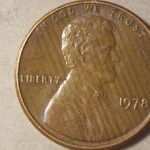So my wife hands me this one and says, "My penny has stripes!" Very naked eye obvious. It looks just like the one Josh found that I used on the glossary entry below. I believe this is an example of what we call "roller lines." If you haven't read Mike Diamond's article that I have linked to below, check it out. Here's the coin. It is very similar to Josh's coin, except the striations on mine are thicker and go in a different direction.

Here is the glossary entry, showing Josh's coin:
Roller Lines: These are very thin parallel striations, often seen on both the obverse and reverse going in the same direction. Though sometimes blamed on improper alloy mixture, these thinner, more even lines are more likely from dirty or damaged rollers from the rolling mill when it was reducing the planchet stock to the correct thickness for coin production. More commonly seen in the late 70s and early 80s. Please see this article by Mike Diamond for more information on striped coinage. http://www.coinworld.com/insights/di...nderstood.html Photo courtesy of jmangham.

Here is the glossary entry, showing Josh's coin:
Roller Lines: These are very thin parallel striations, often seen on both the obverse and reverse going in the same direction. Though sometimes blamed on improper alloy mixture, these thinner, more even lines are more likely from dirty or damaged rollers from the rolling mill when it was reducing the planchet stock to the correct thickness for coin production. More commonly seen in the late 70s and early 80s. Please see this article by Mike Diamond for more information on striped coinage. http://www.coinworld.com/insights/di...nderstood.html Photo courtesy of jmangham.



 Be verwy verwy quiet... I'm hunting coins!!!
Be verwy verwy quiet... I'm hunting coins!!! 
Comment